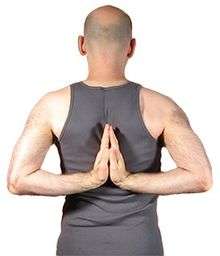Pashchima Namaskarasana
_-_Yoga_Art_and_Science.jpg)

Pashchima Namaskarasana (IPA: [pɐɕtɕ͡iːmɐ nɐmɐskɐːɹɐːsɐnɐː];IAST:Paścima Namaskārāsanā;Sanskrit: पश्चिम नमस्कारासना) is commonly called Reverse Prayer Pose[1] or "Penguin Pose"[2] in English and is a standing yoga asana. It can be considered a variation of Tāḍāsanā.[2][1]
Etymology
Paścima Namaskārāsanā (Sanskrit: पश्चिमे नमस्कारासना) is a compound word: paścima (Sanskrit: पश्चिम) means "being behind";[3][4] namaskāra (Sanskrit: नमस्कार) is a "greeting" or "offering of respect";[5] and āsana (Sanskrit: आसन) means "posture" or "seat".[6]
Description
From Tāḍāsanā the feet are turned out 90 degrees (with the heels remaining together). Hand behind the back, the palms are placed against each other. [2] This hand position can also be called Añjali Mudrā.[7]
Variations
As an alternative to the fingers or palms touching at the back, the wrists[8] or elbows can be grabbed.[1]
Paścima Namaskārāsanā appears in one of the Hasta Vinyāsas.
Practice Points
- When entering the pose, the knees may be bent in order to maintain an upright trunk, then straightened once the hands are in place behind the back.[1]
- When entering the pose, it may be easier to let the shoulders roll forward/upward and open the back (abducting the scapulea), but as the pose deepens the shoulders can relax down and back (adducting the scapulea).[9]
- Do not excessively push the chest and ribs forward, rather bring the back against the hands. [1] The blade of the hands should be firmly against the back. [10]
- Bring the entire palm and all fingers of the hands together evenly, paying special attention to the index finger and thumbs.[1]
- Lift the hands upward[1] to roughly the level of the shoulder blades.[8]
- Open the back, and allow the upper arms to roll forward.[1]
- Should the latissimus dorsi be over-engaged, the ability of the spine to flex will be hindered.[9]
- Continue appropriate pranayama breathing.
- Activate appropriate bandhas.
Effects
This posture opens the abdomen allowing for deeper breath.[11] The posture stretches the pectoral muscles, shoulder joint capsules, and deltoids, as well as numerous upper back muscles.[12]
Cautions
As with Paścima Namaskārāsanā's variation, Tāḍāsanā, those who suffer from headaches, insomnia, or low blood pressure should take care when practicing prolonged standing poses.
Anatomy
This posture primarily affects the scapulea's articulation in relation to the rib cage, and the mobility of the wrists and forearms.[12]
There are numerous joint actions when performing this pose: The downward rotation and adduction of the scapulae toward the rib cage. The glenohumeral joint extends and rotates medially. The elbows are flexed, and forearms pronated, with the wrists dorsiflexed and hands extended.[9]
The muscles at work are the subscapularis, teres major, latissimus dorsi, rhomboids, lower, mid-, and upper trapezius muscles; while the infraspinatus, teres minor, serratus anterior, anterior deltoids, and (if the scapulea are adducted) the pectoralis major and minor are being stretched.[12]
Should the practitioner have particularly tight pectoral muscles, deltoids, or shoulder joint capsules, this posture may be difficult.[12]
References
- 1 2 3 4 5 6 7 8 Fitz-Simon 2010.
- 1 2 3 Ramaswami 2005, p. 3.
- ↑ "Spoken Sanskrit Dictionary: पश्चिम Entry". Retrieved 04-02-2012. Check date values in:
|access-date=(help) - ↑ Monier Williams Sanskrit-English Dictionary. Brown University. 2008. p. 612.
- ↑ "Spoken Sanskrit Dictionary: नमस्कार Entry". Retrieved 04-01-2012. Check date values in:
|access-date=(help) - ↑ "SpokenSanskrit Dictionary: आसन entry". Retrieved 2012-03-11.
- ↑ Ramaswami 2005, p. 8.
- 1 2 Iyengar 2005, p. 46.
- 1 2 3 Kaminoff 2007, p. 72.
- ↑ Coulter 2001, p. 51.
- ↑ Iyengar 2005, p. 47.
- 1 2 3 4 Kaminoff 2007, p. 73.
Bibliography
- Ramaswami, Srivatsa (2005). The Complete Book of Vinyasa Yoga. Da Capo Press. ISBN 9781569244029.
- Iyengar, B. K. S. (1 October 2005). Illustrated Light On Yoga. HarperCollins. ISBN 9788172236069.
- Kaminoff, Leslie (2007). Yoga Anatomy. The Breath Trust. ISBN 978-0736062787.
- Coulter, H. David (2001). Anatomy of Hatha Yoga. Body and Breath Inc. ISBN 978-0970700605.
- Fitz-Simon, Witold (2010). "Arm Variations: Pashchima Namaskarasana". Yoga Art and Science. Retrieved 04-02-2012. Check date values in:
|access-date=(help)